|
CURRENT LAPD RADIO CODES AND PROCEDURES FROM THE DEPARTMENT MANUAL |
Click HERE to go to other incident and disaster audio and video recordings |
What is a "SigAlert?" Find out Here.... |
YOUR VISIT IS INCIDENT # |
"KJC625*" |
Copyright © 1998, 2001 Harry Marnell |
An Unofficial History of the Los Angeles Police Department's Communications Division |
|
CURRENT LAPD RADIO CODES AND PROCEDURES FROM THE DEPARTMENT MANUAL |
Click HERE to go to other incident and disaster audio and video recordings |
What is a "SigAlert?" Find out Here.... |
YOUR VISIT IS INCIDENT # |
|
Desk sergeants and detective offices were equipped with receiving sets, and for important calls, detectives could respond immediately to the scene in their once-famous "fast cars." Soon, radios were installed in sergeants' vehicles, and major calls could be answered by field supervisors as well as by the concerned patrol car. This served as an efficient checking system as well as an added help in case the officers needed any assistance. The two-way system where officers could transmit as well as receive would not come into effect until 1938. Department broadcasts were
heard regularly by the LA Sheriff's Office, the Orange
County Sheriff, the police departments of Beverly Hills,
Alhambra, Santa Monica, Culver City, San Fernando,
Hermosa Beach, Huntington Park, Burbank, Glendale, La
Habra, Moorpark, and as far off as San Clemente. LAPD
would frequently transmit high-priority calls for those
departments' radio-equipped cars. |
|||||
"Calling all cars,
calling all cars..." |
|||||
It should be
remembered that the early 30's were the deepest of the
depression years, and people didn't go out much.
And while radios had become very popular, good radio
programs had not yet been developed. Since police
broadcasts were just above the broadcast band - LAPD was
on 1730 kilocycles (kcs) - most home radios could tune
them in. At night, the signal of LAPD could be
heard all across the country, even as far as the east
coast and Hawaii. (And listeners could not only hear
LAPD, but the then-new CHP had a frequency even lower,
and at night, people could hear both departments' calls
all over the country). |
|
|
|
|||||
An oversized patrol-district map was retained in the central dispatching headquarters, and reduced copies were placed on curtain rollers in each patrol car! Each car on radio patrol duty was equipped with all necessary data so it could be reassigned to a designated district on short notice in emergencies. A centralized teletype system and a statewide teletype system were also operating.
|
|
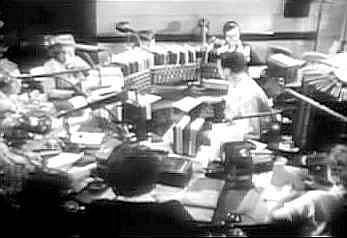 |
| Complaint Board and Mike Room in the Police Department's north wing of City Hall, 1947 | |
|
CLICK HERE TO SEE IT FULL SIZE
|
|
RTOs and status-boards in City
Hall, circa 1950 |
As mentioned, originally 1730 kilocycles (kc) was the dispatchers' "talk out" frequency. When the two-way system was introduced, the cars called in on frequencies in the 39 mc "VHF" range. In 1948, these "talk-in" frequencies moved up to the 154-155 mc band (there were 7 plus the supersecret "frequency 9" for surveillance). Frequency 9 continues in use today as "Tac 1." As the city grew in the 1950's,
and radio traffic increased, a second frequency of 2366
kc was added for dispatching to the Valley, Harbor and
West LA and Venice. |
The San Fernando Valley area dispatching was by then being handled from a separate facility in Van Nuys. (Harbor, West L.A. and Venice had, for many years, the dubious distinction of being referred to at Communications as "outlying" divisions...as if they were somehow perceived as different or second-class). In a major restructuring in 1964 and 1965, "talkout" was changed to the 158-159 MHz radio band, and RTOs eventually had five frequencies (A, B, C, D and E) for dispatching to their respective divisions. |
RTO and status-board at Parker
Center, circa 1968 |
Hot Sheets |
||
Before instantaneous availability of vehicle information by computer, Communications Division Teletype Section would send out, several times a day, "Hot Sheets" of recently stolen and wanted vehicles to all patrol divisions. Note the columns, sorted by the last three digits of the license numbers, from the "Zeroes" through the "Nines." |
||
|
||
| As vehicles were recovered, and
new stolens reported, the Link Operator would
periodically broadcast updates to the current hot sheet,
and officers would update their copies. You
ought to listen soon. These broadcasts have already been
gone for 25 years: 363 kb WAV file -or- 136 kb mp3 file |
||
|
When
the new "Police Administration Building" (later
renamed "Parker Center") opened in 1955,
Communications Division was one of the first facilities
to begin operation. Interestingly enough, though the
space was more than three times as large as the previous
cramped space in the north wing of City Hall, the general
operation continued much as it had for many years. It is
said that many of the operators' "status boards"
were literally carried over from City Hall and installed
in the horse-shoe shaped "mike room" consoles.
Calls continued to be taken by policemen at the complaint
board, and were still sent by a fast conveyor belt into
the radio room. |
|
|
|
|
|
|
|
|
"R.O.V.E.R.s"
The first phase was assignment of new voice radio channels to uniformed divisions, starting with Central Bureau in March, 1981, Valley Bureau in December of that year, and South and West Bureaus followed in July of 1982. First used were the popular "old reliable" Motorola MX-350® handheld radios. It should be remembered
that, until that time, the technology and costs
associated with portable or "handheld" radios
made their widespread use impractical in a city as large
as Los Angeles. |
THESE 8-channel repeatered radios... |
Replaced THESE 4-channel "bricks" (usually called "CC-units" after their transmitter equipment number) |
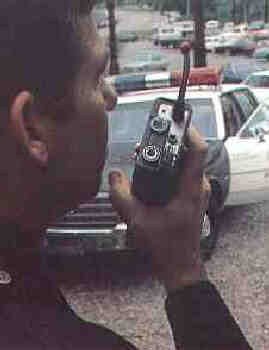 (and now they're quickly being replaced by Astros) |
 |
"ROVER, the
Remote Out-of-vehicle Emergency Radio is a two-watt, 8-channel,
hand-held radio that can be utilized in two environments,
portable and mobile. When used as a portable, the officer
will always have communications available. A Request for
an Automated Want/Warrant System (AWWS) check, for a
supervisor or additional information can be made from
locations away from the vehicle. There will be
approximately 3,500 ROVERs utilized by field forces to
increase officer availability, making it possible to
contact an officer away from his vehicle on a non-emergency
call and reassign him to one of high priority. To utilize
ROVER as a mobile radio, it must be inserted into the
Converta-com, located under the dashboard. The Converta-Com
automatically connects the portable to a mobile
microphone, a high power mobile speaker and an antenna. "The ROVER will transmit the digital tone once every five seconds for thirty seconds. The digital ID is correlated to the officer's unit and location. The requesting officer's voice transmissions will take priority over the emergency code when the push-to-talk bar is activated. To resume normal operations after the emergency has terminated, the officer simply turns the portable off and then back on. |
|
MDTs
For digital
communication with the Mobile Data Terminals in the
police cars, it was decided to use the five former VHF
"voice" dispatch frequency pairs, one for each
geographic bureau and one for city-wide or back-up use. |
|
MDTs give officers a second means of communication with the dispatch center and with each other. A significant number of messages do not require voice communications, such as routine status changes and database inquiries. The MDTs have typewriter-like keyboards, computer-like monitors, and 16 "status" and other standard message buttons. |
|
|||||
CDC Opens ... and 9-1-1 arrives The computer-assisted dispatch system went online in the new "Central Dispatch Center," four stories below City Hall East, at 4:00 a.m. on Sunday April 17, 1983. Dispatching for the five patrol areas of the Valley Bureau was transferred from their former "mike room" in Van Nuys. After a 6-month shake-down period, the three remaining bureaus went online in October. Three months later, in
January of 1984, the 9-1-1 emergency
number became operational throughout the City of Los
Angeles. In nine short (but well-planned for) months,
LAPD's communications system had undergone a complete
make-over. |
|||||
| The
CDC is
equipped with 62 consoles and terminals, including: |
|||||
Operators ("Police Service Representatives") are assigned daily to either a radio-dispatching position, a 9-1-1 phone position or another auxiliary telephone assignment.
|
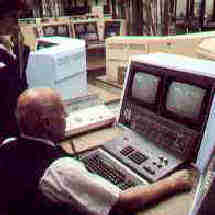 |
||||
| 4
Bureau Communications Coordinator consoles: The "BCCs"
are supervisory operators, who also perform additional
duties, such as using extra voice radio frequencies when
needed, inputting additional computer commands, and
monitoring the telephone system operation. |
|||||
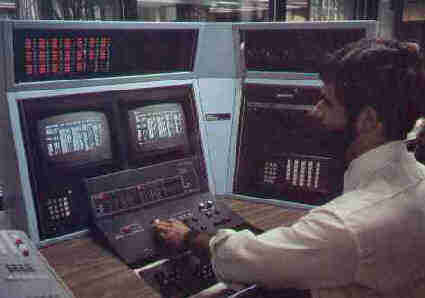 |
System
Monitor Operator |
||||
|
|||||
BE ON THE LOOKOUT ! Here's what the future has in store for LAPD Communications When the CDC opened in 1983, it embodied the future of law enforcement communications in Los Angeles. However, within a year of the center's opening, the call-volume had surpassed estimates for the 1990s. Currently approximately 6000 emergency calls and 8000 non-emergency calls are received daily, and about 5500 of these are dispatched to police units. This has caused a number of problems, mainly because of the lack of room to expand. Over 600 employees are assigned to Communications Division. Dispatching is handled by civilian Police Service Representatives (PSRs), with as many as 90 people on the dispatch floor at any given time, including supervisors and trainees. A 1992 bond issue to revamp communications once again is about to come to fruition. Expected to cost a total of $250 million, two new "state-of-the-art" dispatch centers are nearing completion - one at 1st and Los Angeles Streets, next to Parker Center Police Headquarters, and the other 23001 Roscoe Blvd in Canoga Park. The downtown "Metropolitan
Communications Dispatch Center"
will generally handle the nine patrol areas and two
traffic divisions in Central and South Bureaus, while the
"Valley
Communications Dispatch Center"
will handle calls for the nine patrol areas and two
traffic divisions in the West and Valley Bureaus. The
two centers will at all times be connected with each
other in real-time by fiber-optic and microwave networks;
in the event of a disaster, equipment failure or problem
at either center, the other will be able to absorb some
or all of the workload almost instantly. |
| A completely new radio "backbone" system is being constructed, with a 109-channel UHF and VHF frequency plan, operable in either analog or digital mode, with advanced encryption (scrambling) available as well. All existing mobile and portable radios are in the process of being replaced with new equipment, and one of the department's priorities is to acquire handheld portable data terminals first for all motorcycle officers, and then for foot and bicycle patrol officers. | 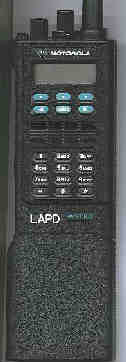 |
|
Astro Saber III® Portable Radio |
||
|
||
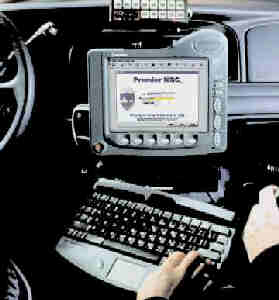 PHOTO COURTESY OF MOTOROLA MW-520® Mobile Digital Terminal |
About 1200 new Motorola MW-520® vehicle MDTs have already been installed, and when the new system is completed in 2002 all 1400 patrol vehicles will be so equipped. The new data system has already been accepted and is in use, with twice as many channel pairs as before, and data speeds approximately eight times faster than the old system. |
|
Construction of the Dispatch
Centers is expected to be complete in 2001, and both
should be furnished, staffed and operating by the end of
2002. |
"Stand by for further information..." Southern California Fire Communications Frequencies & Links *KMA367 was the FCC callsign for most of
LAPD's radio transmitters from the late 1940s to the
early 1980s, when the UHF-band "ROVER" radio
frequencies went into operation. This included the
"AM" band frequencies heard across the country
and the VHF frequencies which followed them.
Because of the wide coverage on the AM band, and its use
on such TV shows as "Dragnet" and "Adam-12,"
KMA367 will probably be associated with the Los Angeles
Police Department for years to come. There are
still a handful of special-use frequencies with those
call-letters, but the booming "KMA367" on the
dispatch channels has been replaced with a recorded
"KJC625." |
I'd appreciate it if you would take a quick second and go here... "CONTINUE
PATROL..." Then click on one of these links, print it out, and take it to work with you tomorrow... |